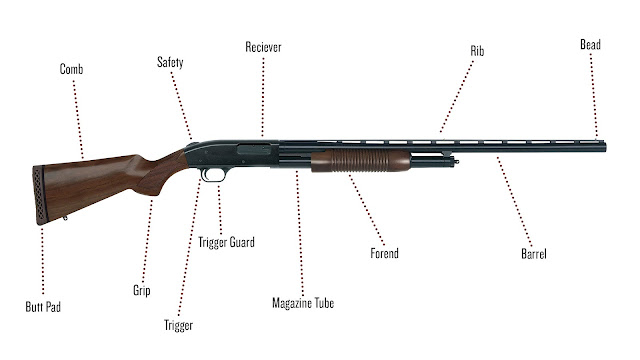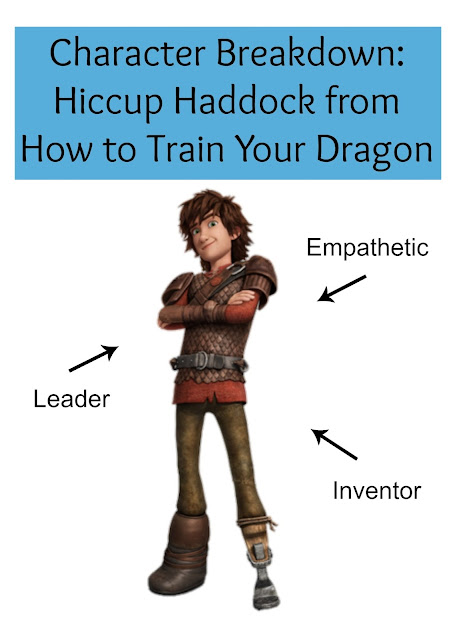Writing Tips: Guns and Shooting

So I thought I'd share some of the things I know about shooting and guns for all you writers out there. Use these tips to make your shooting scenes more realistic and avoid drawing the reader out of the narrative when reading.
For reference, here are the basic parts of a shotgun and pistol before we begin.
#1: Guns move when they shoot.
This is called recoil, or kick. The force of the bullet traveling forward pushes the gun back and the muzzle up. If you aren't holding the gun properly, this kick can cause you to wildly miss your target and, in the case of shotguns, hurt your shoulder.
Another thing to note is the bigger the gun, the bigger the kick (most of the time). That shoulder held grenade launcher is gonna move a lot compared to a regular hunting rifle.
Interestingly enough, the smaller a gun is, the more kick it will also have. Every time I see a movie character pull out a tiny pocket pistol, I wince, because I know when they shoot that, it's gonna kick so much. This is because a larger handgun has more mass to absorb the recoil. A tiny gun has almost nothing, so you end up absorbing the recoil in your hands.
#2: Bullet cases fly around when shooting.
The bullet is actually only one part of the larger ammunition cartridge. That's the part that's shot out the front of the gun via an explosion of gunpowder held inside the cartridge.
In order to shoot another round, the previous one has to get out of the gun's chamber. It does this buy expelling the case to the side. (You can see this in the pistol GIF above.)
Because bullets are fired via explosion, these cases are hot. And a lot of times, they're gonna hit anyone standing beside you, or if you're real unlucky, they'll come back and hit you in the face. That's why they recommend using eye protection when shooting (when you can).
It's startling, but most of the time harmless. A trained marksman won't even flinch when this happens. It can be freaky to a beginner, so keep that in mind when writing new shooters.
#3: Target shooting and defensive shooting are completely different.
While there is crossover, these two types of shooting have different goals and ways of going about them.
Target shooting is generally used for mastering marksmanship and competing. Its focus is hitting as close to the bullseye as possible, as consistently as you can. It prioritizes accuracy above all else.
Defensive shooting, which most book characters will use, is about defending yourself, generally by wounding or killing the other person. While knowing how to hit your target accurately is important, you have a much larger target area. If you can hit your attacker's torso with all the shots in your magazine, they aren't going to come after you anymore.
Defensive shooting also involves moving while shooting. You can't stand there like a block of wood, especially if someone is shooting back at you. You have to learn to move, fire accurately from cover, and reload your gun quickly.
#4: Form is important.
Something as small as a poor grip on your pistol can cause it to misfire, hurting yourself and others. Form is key to shooting well and accurately. It's how you hit what you're aiming at and get back on target to shoot again quickly.
Your stance can change slightly depending on what type of gun you're shooting (shotgun or pistol), how you were trained, and personal preference. But it generally involves having a wide stance with your feet, keeping your knees soft to absorb recoil, and holding your gun tightly.
Personally, I stand with my legs wider than hip width apart, my arms held at shoulder height with a slight bend, and sight with my left eye. An instructor I had tried to teach me a different method, but it didn't work well for me. This stance is how I feel most comfortable and it's too ingrained in me to change now.
Check out this post for a basic overview of some stances you can do.
#5: Guns are loud.
This might seem obvious, but if you've never heard a gun going off in real life, especially when you're the one holding it, they are far louder than the movies make them seem. Again, you are creating an explosion that propels a bullet through the area. Not only that, but most bullets actually break the sound barrier, helping create that sharp crack you hear.
Bigger guns are going to be louder than smaller ones. You can hear assault rifles a quarter of a mile away, maybe more. Even a small pistol makes a good bit of noise. That's why another piece of safety gear used while shooting is ear protection, whether in ear or over ear.
In emergency situations, you obviously can't use those. So if your character has to shoot without them, their ears are going to ring for a bit afterwards. And if they're on a battlefield, it's going to be deafening.
Tips for Writers
Alright, I want to end this post by giving you a few quick things to keep in mind when writing a character using a firearm.
• Consider how much experience they have. New shooters are often afraid of their firearm and use poor form. Experienced marksmen are calm, collected, and handle firearms like it's second nature (because it is). Where on the scale does your character lie?
• How skilled at they? Like anything else, shooting is a skill. It takes practice and repetition to get good. Has your character only shot once before, or do they handle guns daily?
• Shooting with two hands is practically impossible, so just don't have your character do it. I'm sure there's some people who have figured it out, but realistically, you can't aim and fire two pistols and expect to hit your target.
• Do you research. There are a lot of different types of guns, holsters, techniques, and more involved with firearms. You may not know the difference between a Glock and a Smith and Weston, or appendix holster versus a shoulder holster, but your readers might.
• If you can, take a shooting class. Get out there and see how guns work in the real world. No research compares to real life experience.
I hope this helps any of you writers out there, whether your character is hunting with a shotgun or going all John Wick on their enemies.









Comments
Post a Comment